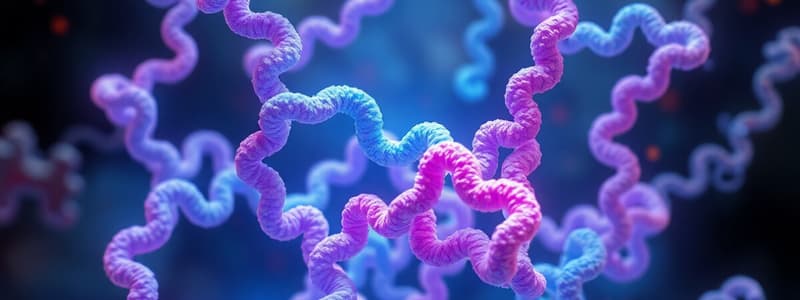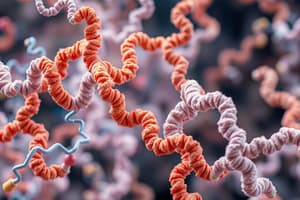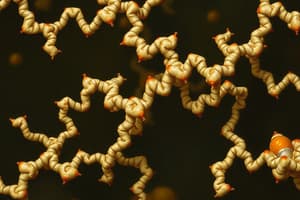Podcast
Questions and Answers
What is the role of tyrosinase in protein synthesis?
What is the role of tyrosinase in protein synthesis?
Tyrosinase is an enzyme that links together amino acids in the correct sequence to build proteins.
How do digestive enzymes like amylase function in the body?
How do digestive enzymes like amylase function in the body?
Amylase breaks down complex carbohydrates into simpler sugars during digestion.
Explain the significance of the Lock & Key model in understanding enzyme function.
Explain the significance of the Lock & Key model in understanding enzyme function.
The Lock & Key model illustrates that the active site of an enzyme is specifically shaped to fit a particular substrate, facilitating the reaction.
What distinguishes enzymes from other biological catalysts?
What distinguishes enzymes from other biological catalysts?
Give an example of an enzyme and its corresponding substrate it acts upon.
Give an example of an enzyme and its corresponding substrate it acts upon.
What is the primary advantage of the zigzag structure in chain proteins?
What is the primary advantage of the zigzag structure in chain proteins?
Define tertiary structure in proteins.
Define tertiary structure in proteins.
What characterizes quaternary structure in proteins?
What characterizes quaternary structure in proteins?
How does the amino acid sequence influence a protein's conformation?
How does the amino acid sequence influence a protein's conformation?
What role do molecular chaperones play in protein folding?
What role do molecular chaperones play in protein folding?
What happens during protein denaturation?
What happens during protein denaturation?
What determines the biological role of a protein?
What determines the biological role of a protein?
Describe the function of enzymes in biological processes.
Describe the function of enzymes in biological processes.
What are the two functional groups present in all amino acids?
What are the two functional groups present in all amino acids?
Describe the primary, secondary, and tertiary structures of proteins.
Describe the primary, secondary, and tertiary structures of proteins.
What roles do molecular chaperones play in protein synthesis?
What roles do molecular chaperones play in protein synthesis?
How do enzymes function as specialized proteins in the body?
How do enzymes function as specialized proteins in the body?
What element makes proteins nitrogen-rich compared to other biological molecules?
What element makes proteins nitrogen-rich compared to other biological molecules?
What role do the R groups play in amino acids?
What role do the R groups play in amino acids?
What distinguishes non-polar amino acids from polar amino acids?
What distinguishes non-polar amino acids from polar amino acids?
Why are proteins considered the most abundant organic molecules in living systems?
Why are proteins considered the most abundant organic molecules in living systems?
What are the two classifications of polar amino acids based on the charge of their R groups?
What are the two classifications of polar amino acids based on the charge of their R groups?
Describe the process of how a peptide bond is formed between two amino acids.
Describe the process of how a peptide bond is formed between two amino acids.
What are the four levels of protein structure?
What are the four levels of protein structure?
How does the primary structure of a protein influence its overall function?
How does the primary structure of a protein influence its overall function?
What is the role of hydrogen bonding in the formation of secondary structures in proteins?
What is the role of hydrogen bonding in the formation of secondary structures in proteins?
What characterizes the a-helix structure in proteins?
What characterizes the a-helix structure in proteins?
Explain the difference between the a-helix and β-sheet secondary structures.
Explain the difference between the a-helix and β-sheet secondary structures.
What is the significance of the rigid nature of peptide bonds in protein structure?
What is the significance of the rigid nature of peptide bonds in protein structure?
Flashcards
What are enzymes?
What are enzymes?
Enzymes are biological catalysts that speed up chemical reactions in living organisms without being consumed in the process.
What is the lock and key model of enzyme action?
What is the lock and key model of enzyme action?
Each enzyme has a specific shape called the active site, which fits a specific molecule called the substrate. This ensures that the enzyme only interacts with its intended target.
Are enzymes used up during a reaction?
Are enzymes used up during a reaction?
Enzymes are not used up in a reaction. They can be reused repeatedly to catalyze the same reaction with other substrate molecules.
How are enzymes named?
How are enzymes named?
Signup and view all the flashcards
How efficient are enzymes?
How efficient are enzymes?
Signup and view all the flashcards
Positively Charged Amino Acids
Positively Charged Amino Acids
Signup and view all the flashcards
Negatively Charged Amino Acids
Negatively Charged Amino Acids
Signup and view all the flashcards
Peptide Bond
Peptide Bond
Signup and view all the flashcards
Primary Structure
Primary Structure
Signup and view all the flashcards
Secondary Structure
Secondary Structure
Signup and view all the flashcards
Alpha Helix
Alpha Helix
Signup and view all the flashcards
Beta Sheet
Beta Sheet
Signup and view all the flashcards
Tertiary Structure
Tertiary Structure
Signup and view all the flashcards
Fibroin
Fibroin
Signup and view all the flashcards
Quaternary structure
Quaternary structure
Signup and view all the flashcards
Conformation
Conformation
Signup and view all the flashcards
Denaturation
Denaturation
Signup and view all the flashcards
Molecular chaperones
Molecular chaperones
Signup and view all the flashcards
Enzymes
Enzymes
Signup and view all the flashcards
What are proteins?
What are proteins?
Signup and view all the flashcards
What are amino acids?
What are amino acids?
Signup and view all the flashcards
What is a peptide bond?
What is a peptide bond?
Signup and view all the flashcards
What is the primary structure of a protein?
What is the primary structure of a protein?
Signup and view all the flashcards
What is the secondary structure of a protein?
What is the secondary structure of a protein?
Signup and view all the flashcards
What is the tertiary structure of a protein?
What is the tertiary structure of a protein?
Signup and view all the flashcards
What is the quaternary structure of a protein?
What is the quaternary structure of a protein?
Signup and view all the flashcards
Describe the role of molecular chaperones.
Describe the role of molecular chaperones.
Signup and view all the flashcards
Study Notes
Biological Molecules: Proteins
- Proteins are derived from the Greek word proteios, meaning "holding first place".
- They are the most abundant organic molecules in living systems. Over 100,000 different proteins exist.
- Proteins are present in every part of a cell and make up approximately 50% of the cellular dry weight.
- Proteins are fundamental for structure and function in life. They significantly influence a cell's appearance and functions.
Learning Outcomes
- Describe amino acid structure and the characteristics of the peptide bond.
- Explain polypeptide primary, secondary, and tertiary structure.
- Describe the role of structural and functional domains in protein tertiary structure.
- Explain the role of molecular chaperones in protein synthesis.
- Explain the role of enzymes in the body.
Proteins
- Proteins are polymers of amino acids.
- Amino acids contain two functional groups; an amino group (-NH2), and a carboxyl group (-COOH).
- Out of approximately 300 amino acids found in nature, only 20 are considered standard amino acids, appearing repeatedly in proteins.
Amino Acids - Building Blocks
- Amino acids are organic compounds.
- They are the basic building blocks of proteins, repeatedly occurring in their structure.
Amino Acid Structure
- All amino acids have a similar structure.
- They are known as alpha-amino acids as both carboxyl and amino groups are bonded to the alpha carbon.
- The alpha carbon also bonds to a R-group (side chain), which varies for each of the 20 amino acids.
Classification Based on Polarity
- Nonpolar: Hydrophobic; lack charge on their R-groups.
- Polar: Possess groups like hydroxyl and amide; participate in hydrogen bonding within protein structure. Lack charge on their R-groups.
Classification Based on Polarity (Electrically Charged)
- Positive charge: Polar amino acids with positive R-groups. (e.g., Lysine, Arginine, Histidine)
- Negative charge: Polar amino acids with negative R-groups. (e.g., Aspartic Acid, Glutamic Acid)
Peptide Bond
- A covalent bond that connects amino acids.
- Formed by removing a water molecule from the amino group of one amino acid and the carboxyl group of the adjacent amino acid.
- Creates a dipeptide, and extends to form polypeptides, and ultimately proteins (starting from the N-terminus).
Protein Structure
- Proteins have four levels of organization:
- Primary: Amino acid sequence.
- Secondary: Hydrogen bonding between amino acids results in structures like alpha-helices and beta-sheets.
- Tertiary: Interactions among side chains fold the protein into a 3D structure.
- Quaternary: Several polypeptide chains associate to form a larger structure.
Primary Structure
- The linear sequence of amino acids in a protein is its primary structure.
- This structure heavily influences the protein's function.
- Example: The first six amino acids in hemoglobin.
Secondary Structure
- Forming hydrogen bonds, the primary structure organizes into a compact structure.
- The alpha-helix and beta-sheet (parallel or antiparallel) are the most common structures.
- Keratin is an example.
Tertiary Structure
- The interactions between side chains bring about the protein's 3D conformation.
- Hydrogen and ionic bonding influence this process.
- RNA is one example.
Quaternary Structure
- Multiple polypeptide chains bond to form a complex structure.
- This interaction involves hydrogen bonds and Van der Waals forces between nonpolar side chains.
- Hemoglobin is an illustration.
Why Do Proteins Have Different Conformations?
- The amino acid sequence dictates the protein's conformation.
- Proteins normally fold into a single stable conformation initially.
- Environmental factors, like pH and temperature, can cause slight changes or even denaturation (unfolding). Denaturation disrupts hydrogen and ionic bonds, which often leads to a change in shape and loss of biological activity.
Molecular Chaperones
- Specialized proteins that aid in protein folding or unfolding.
- Facilitate and regulate protein conformational changes.
- Assist in the correct folding of proteins during or after synthesis.
What Determines a Protein's Biological Role/Activity?
- The entire protein's structure defines its role.
- Different protein regions can have varying functions.
- Variations in amino acid sequence, and the resulting 3D structure, define protein specialization.
Function of Proteins
- Enzymes: Speed up biochemical reactions. Examples include amylase (digestion) and diastase (starch to maltose conversion).
- Transport: Carry molecules. Examples include hemoglobin (oxygen transport), and albumin (lipoproteins transport).
- Storage: Store molecules. Examples include ferritin (iron).
- Others: Defensive, hormonal, structural, to name a few.
Enzymes
- Enzymes are proteins that speed up metabolic reactions.
- Each enzyme catalyzes a specific reaction.
- Enzymes are reusable.
- Enzymes are needed in small quantities, typically converting thousands of molecules per second.
- Enzyme functions are dependent on their shape and the ‘lock and key’ interactions with the substrate.
Studying That Suits You
Use AI to generate personalized quizzes and flashcards to suit your learning preferences.




